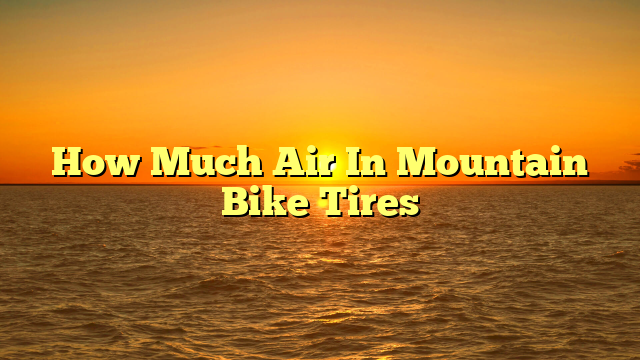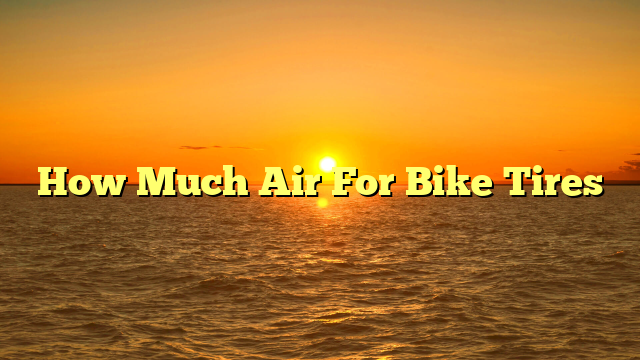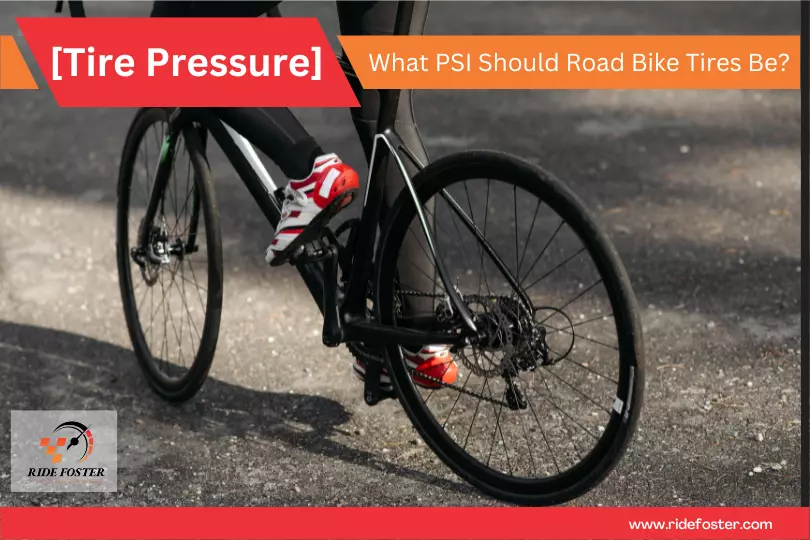Proper tire inflation is crucial for the performance and safety of a mountain bike.
The right tire pressure not only affects your ride quality but also impacts the longevity of your tires.
Finding the ideal tire pressure can be challenging, as there are several factors that come into play, such as rider weight, riding style, and tire size.
Factors such as terrain, weather conditions, and personal preferences can also affect tire pressure.
Overinflated tires can reduce traction and make the ride harsh, while underinflated tires can cause pinch flats and increase the risk of punctures.
Therefore, it is essential to determine the correct tire pressure for your weight and riding style and regularly check and adjust the pressure as needed.
This article will delve into the importance of proper tire inflation in mountain biking, the factors that affect ideal tire pressure, and how to determine the right tire pressure for your bike.
Table of Contents
- 1 Key Takeaways
- 2 Importance of Proper Tire Inflation in Mountain Biking
- 3 Factors that Affect Ideal Tire Pressure
- 4 Determining the Right Tire Pressure for Your Weight
- 5 Adjusting Tire Pressure for Different Riding Styles
- 6 Tire Size and its Impact on Air Pressure
- 7 Tools and Techniques for Measuring Tire Pressure
- 8 Tips for Maintaining Optimal Tire Inflation
- 9 Common Mistakes to Avoid when Inflating Mountain Bike Tires
- 10 Frequently Asked Questions
- 10.1 How often should I check my tire pressure while mountain biking?
- 10.2 Can I use the same tire pressure on different types of terrain?
- 10.3 How does tire pressure affect the lifespan of my mountain bike tires?
- 10.4 Should I inflate my tires differently based on the temperature or weather conditions?
- 10.5 Can using a tire sealant affect my tire pressure readings?
- 11 Conclusion
Key Takeaways
- Proper tire inflation is crucial for both performance and safety while riding a mountain bike.
- Tire pressure should be regularly checked and adjusted based on factors like rider weight, riding style, and tire size.
- Overinflated and underinflated tires can both negatively affect ride quality and increase the risk of accidents.
- Measuring tire pressure accurately with tools like digital pressure gauges is essential for optimal performance, safety, and comfort.
Importance of Proper Tire Inflation in Mountain Biking
The importance of maintaining proper tire inflation in mountain biking cannot be overstated, as it directly affects the performance, safety, and overall experience of the rider.
A tire that is incorrectly inflated can cause a rider to lose control of their bike, leading to accidents and injuries.
Additionally, underinflated tires can make pedaling more difficult, while overinflated ones can cause a harsh and uncomfortable ride.
One of the benefits of tubeless tires is that they allow for lower tire pressure, which can improve traction and reduce the risk of pinch flats.
However, riders must still ensure that their tubeless tires are inflated to the appropriate level for the conditions they will be riding in.
It’s worth noting that tire pressure can vary depending on the weather, as temperature changes can affect the air pressure in the tires.
Therefore, it’s essential for mountain bikers to regularly check and adjust their tire pressure to ensure that they are riding with the appropriate amount of air in their tires.
Factors that Affect Ideal Tire Pressure
Various factors can impact the recommended pressure for optimal performance and safety of a tire.
One of the most important factors is the weather.
In colder temperatures, the air in the tire will contract and cause a decrease in pressure.
On the other hand, in warmer temperatures, the air in the tire will expand and cause an increase in pressure.
Therefore, it is crucial to check tire pressure regularly and adjust accordingly based on the weather conditions.
Another significant factor that affects ideal tire pressure is the terrain.
Different terrains require different tire pressures for optimal performance.
For example, when riding on rocky terrain, a lower tire pressure can provide better grip and traction.
However, when riding on a smoother surface, a higher tire pressure can allow for faster speed and better handling.
It is essential to adjust tire pressure based on the terrain being ridden to ensure safety and performance.
Riding on an overinflated tire can lead to a harsh and uncomfortable ride.
Riding on an underinflated tire can cause damage to the rim and decrease the lifespan of the tire.
Proper tire pressure can improve traction and grip, providing better control over the bike.
Tire pressure can impact the rolling resistance of the bike, affecting overall speed and performance.
Regularly checking tire pressure can help prevent punctures and blowouts, ensuring a safe and enjoyable ride.
Overall, understanding the factors that affect ideal tire pressure is crucial for optimal performance and safety in mountain biking.
Checking tire pressure regularly and adjusting accordingly based on the weather and terrain can improve grip, speed, and handling, while also preventing damage to the tire and rim.
It is essential to prioritize tire maintenance to ensure a safe and enjoyable ride.
Determining the Right Tire Pressure for Your Weight
One important consideration for achieving the optimal tire pressure in mountain bike tires is determining the appropriate amount of inflation based on rider weight.
This is because the weight of the rider can affect the amount of pressure needed to support the bike and provide the necessary traction for the terrain.
To determine the appropriate tire pressure for your weight, you can use a simple calculation that involves dividing your weight in pounds by 7, and then adding or subtracting 2-3 PSI based on your personal preference and the type of terrain you will be riding on.
To ensure that you are accurately measuring your tire pressure, it is recommended to use a high-quality tire pressure gauge from a reputable brand.
The accuracy of the tire pressure gauge can have a significant impact on the performance and safety of your bike, so it’s important to invest in a reliable tool.
Some recommended brands for tire pressure gauges include Topeak, Park Tool, and SKS.
By using the appropriate tire pressure for your weight and investing in a reliable tire pressure gauge, you can optimize the performance and safety of your mountain bike.
| Rider Weight (lbs) | PSI Calculation | Adjusted PSI (based on personal preference and terrain) |
|---|---|---|
| 100-120 | 14-17 | +2-3 PSI |
| 120-140 | 17-20 | +2-3 PSI |
| 140-160 | 20-23 | +2-3 PSI |
Adjusting Tire Pressure for Different Riding Styles
Adjusting tire pressure to accommodate different riding styles can significantly improve the performance and safety of the rider, as varying terrain and riding conditions require different levels of traction and stability.
Mountain bikers should adjust their tire pressure based on the specific terrain they will be riding on, as well as their own personal preferences and riding style.
Here are some factors to consider when adjusting tire pressure for different terrains:
- Hard-packed dirt: Riders should use higher tire pressure, as this terrain offers more traction and stability.
This will also help prevent pinch flats and provide faster rolling speed.
- Loose or sandy terrain: Lower tire pressure is recommended for these types of terrain, as it allows the tire to better grip the ground and maintain control.
However, be cautious not to lower the pressure too much, as this can lead to rim damage or tire burps.
- Technical or rocky terrain: A slightly lower tire pressure will help absorb impact from rocks and provide better traction on uneven surfaces.
However, be careful not to go too low, as this can negatively impact suspension and stability.
It is important to note that adjusting tire pressure can also impact the performance of the suspension.
Lower tire pressure can lead to a softer ride and more suspension movement, while higher tire pressure can lead to a stiffer ride and less suspension movement.
As such, riders should experiment with adjusting both tire pressure and suspension settings to find the ideal combination for their specific riding style and terrain.
Tire Size and its Impact on Air Pressure
The size of a tire significantly impacts the recommended pressure for optimal performance and safety.
Choosing the right tire size can greatly affect a mountain bike’s performance, especially when it comes to traction and stability.
A larger tire size allows for more grip and stability, which can be beneficial for riders who prefer aggressive riding styles or for those who ride in rough terrain.
However, a larger tire size also requires a lower psi (pounds per square inch) to maintain optimal performance.
On the other hand, a smaller tire size may be more suitable for riders who prefer a lighter and more nimble ride, but it also requires a higher psi to maintain optimal performance.
To illustrate the impact of tire size on air pressure, the following table shows the recommended psi for different tire sizes based on the rider’s weight:
| Tire Size | Rider Weight | Recommended PSI |
|---|---|---|
| 26″ | <120 lbs | 25-30 psi |
| 26″ | 120-140 lbs | 30-35 psi |
| 26″ | 140-170 lbs | 35-40 psi |
| 26″ | >170 lbs | 40-45 psi |
| 27.5″ | <120 lbs | 23-28 psi |
| 27.5″ | 120-140 lbs | 28-33 psi |
| 27.5″ | 140-170 lbs | 33-38 psi |
| 27.5″ | >170 lbs | 38-43 psi |
| 29″ | <120 lbs | 20-25 psi |
| 29″ | 120-140 lbs | 25-30 psi |
| 29″ | 140-170 lbs | 30-35 psi |
| 29″ | >170 lbs | 35-40 psi |
It’s essential to keep in mind that these recommended psi ranges are just a starting point, and riders should adjust their tire pressure based on their preferences and riding style.
Deviating from these recommendations may affect the bike’s performance and safety.
Therefore, it’s crucial to find the ideal tire pressure that provides optimal traction, stability, and comfort while riding.
Tools and Techniques for Measuring Tire Pressure
Measuring tire pressure accurately is crucial to ensure optimal performance, safety, and comfort while riding, and there are various tools and techniques available for this purpose.
Here are some of the most common methods to measure tire pressure:
- Tire Pressure Gauge: A tire pressure gauge is a handheld device that measures the air pressure inside the tire.
It is a simple and accurate tool, and most gauges are calibrated to measure the pressure in pounds per square inch (PSI).
- Digital Pressure Gauge: A digital pressure gauge is similar to a standard tire pressure gauge, but it uses a digital display to show the reading.
Digital gauges are more accurate and easier to read than traditional gauges.
- Air Compressor: An air compressor is a machine that can inflate tires quickly and efficiently.
It is an excellent tool for those who frequently need to inflate their tires.
- Alternate Methods: There are also various alternate methods for measuring tire pressure, such as using the thumb test or checking the tire’s appearance.
However, these methods are not as accurate as using a tire pressure gauge or digital pressure gauge.
By using these tools and techniques, riders can ensure that their tires are properly inflated, which will improve performance, safety, and comfort while riding.
Tips for Maintaining Optimal Tire Inflation
Maintaining optimal tire inflation is essential for ensuring a safe and comfortable riding experience, as well as extending the lifespan of the tires.
One way to achieve this is by using tubeless tires.
These tires do not require an inner tube, which means that there is no risk of pinch flats or punctures caused by the inner tube.
This reduces the likelihood of flat tires, which can ruin a ride or even cause accidents.
Tubeless tires also provide a smoother ride, as they can be run at lower pressures without the risk of pinch flats.
This translates to better traction and control, especially on rough terrain.
Another way to maintain optimal tire inflation is by using nitrogen instead of air.
Nitrogen molecules are larger than air molecules, which means that they are less likely to leak out of the tire.
This results in a more stable tire pressure, which in turn leads to better fuel efficiency and longer tire life.
Nitrogen also has the added benefit of reducing oxidation and moisture buildup within the tire, which can cause corrosion and damage over time.
However, it is important to note that nitrogen must be filled by a trained professional, as it requires special equipment and expertise.
Overall, maintaining optimal tire inflation through the use of tubeless tires and nitrogen can greatly improve the riding experience and prolong the life of the tires.
Common Mistakes to Avoid when Inflating Mountain Bike Tires
Properly inflating your mountain bike tires can be a challenge, but avoiding common mistakes can make the process smoother and more efficient.
One of the most common mistakes is overinflating your tires.
Overinflated tires can lead to a harsh and uncomfortable ride, and can also increase the risk of punctures and other damage.
It’s important to follow the manufacturer’s guidelines for maximum tire pressure, which can usually be found on the sidewall of the tire.
Additionally, it’s important to check the pressure regularly and adjust as needed, as changes in temperature and riding conditions can affect tire pressure.
On the other hand, underinflating your mountain bike tires can also lead to problems.
Tires that are underinflated can feel sluggish and unresponsive, and can also be more prone to pinch flats and other types of damage.
Again, it’s important to follow the manufacturer’s guidelines for minimum tire pressure and to check the pressure regularly.
It’s also important to note that different types of terrain may require different levels of tire pressure.
For example, softer surfaces like mud or sand may require lower tire pressure for better traction, while harder surfaces like pavement may require higher tire pressure for maximum efficiency.
By avoiding overinflation and underinflation mistakes, you can ensure that your mountain bike tires are properly inflated for a smoother, more efficient ride.
Frequently Asked Questions
How often should I check my tire pressure while mountain biking?
Tire pressure maintenance is crucial for safe and efficient mountain biking.
Proper inflation ensures optimal traction and reduces the risk of punctures.
Checking tire pressure before every ride is recommended to ensure the tire is properly inflated.
Can I use the same tire pressure on different types of terrain?
The optimal tire pressure for different types of terrain depends on adjusting pressure to the tire tread.
There is no one-size-fits-all answer, as pressure should be adjusted based on the specific terrain to improve traction and control.
How does tire pressure affect the lifespan of my mountain bike tires?
Tire pressure significantly impacts the lifespan of mountain bike tires, with low pressure leading to increased wear and reduced performance.
Properly inflated tires distribute weight evenly, reducing the risk of damage and ensuring optimal performance over time.
Should I inflate my tires differently based on the temperature or weather conditions?
The optimal PSI for mountain bike tires depends on various factors like rider weight, terrain, and tire flexibility.
In colder weather, the tire pressure should be slightly lower to increase tire flexibility and improve traction.
Can using a tire sealant affect my tire pressure readings?
The use of tire sealant benefits mountain bikers by providing puncture protection, but it can affect tire pressure readings if not applied properly.
It’s important to follow proper sealant application guidelines to ensure accurate pressure readings.
Conclusion
Proper tire inflation is crucial for a safe and enjoyable mountain biking experience.
The ideal tire pressure is influenced by various factors such as rider weight, riding style, and tire size.
Determining the correct tire pressure is essential for optimal performance and safety on the trails.
Measuring tire pressure accurately can be achieved through various tools and techniques such as using a digital pressure gauge or a floor pump with a built-in pressure gauge.
Proper maintenance of tire inflation includes checking tire pressure before every ride, avoiding overinflation or underinflation, and keeping an eye on tire wear and tear.
Common mistakes to avoid when inflating mountain bike tires include overlooking the recommended tire pressure range, neglecting to factor in rider weight, and failing to adjust tire pressure based on riding conditions.
In conclusion, understanding the importance of proper tire inflation and the factors that affect it is crucial for any mountain biker.
Adjusting tire pressure based on individual factors such as rider weight and riding style, as well as regular maintenance, will ensure a safe and enjoyable ride.
By avoiding common mistakes when inflating mountain bike tires, riders can maximize their performance and safety on the trails.







